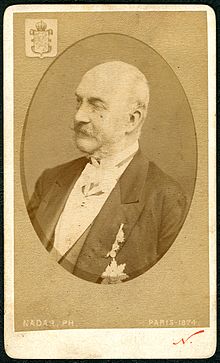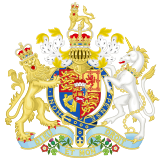George V of Hanover
| George V | |||||
|---|---|---|---|---|---|
 | |||||
| King of Hanover | |||||
| Reign | 18 November 1851 – 20 September 1866 | ||||
| Predecessor | Ernest Augustus | ||||
| Born | 27 May 1819 Berlin, Prussia | ||||
| Died | 12 June 1878 (aged 59) Paris, France | ||||
| Burial | |||||
| Consort | Marie of Saxe-Altenburg | ||||
| Issue | Ernest Augustus, Crown Prince of Hanover Princess Frederica of Hanover Princess Marie of Hanover | ||||
| |||||
| House | Hanover | ||||
| Father | Ernest Augustus, King of Hanover | ||||
| Mother | Frederica of Mecklenburg-Strelitz | ||||
| Signature | |||||
George V (George Frederick Alexander Charles Ernest Augustus; German: Georg Friedrich Alexander Karl Ernst August; 27 May 1819 – 12 June 1878) was the last king of Hanover, the only child and successor of King Ernest Augustus. George V's reign was ended by the Unification of Germany.
Early life
Prince George of Cumberland was born in Berlin, the only son of Prince Ernest Augustus, Duke of Cumberland, himself fifth son of George III, and his wife Princess Frederica of Mecklenburg-Strelitz on 27 May 1819.
He was baptized on 8 July 1819, at a hotel in Berlin where his parents were staying, by the Rev. Henry Thomas Austen (brother of author Jane Austen). His godparents were the Prince Regent (represented by the Duke of Cumberland), the King of Prussia, the Emperor of Russia, the Crown Prince of Prussia, Prince William of Prussia, Prince Frederick Louis of Prussia, Prince Henry of Prussia, the Prince William of Prussia, Grand Duke of Mecklenburg-Strelitz, Duke Charles of Mecklenburg, the Empress Maria Feodorovna of Russia, the Queen of the Netherlands, the Princess Augusta Sophia, the Hereditary Princess of Hesse-Homburg, the Duchess of Gloucester and Edinburgh, Princess Sophia, Princess Alexandrine of Prussia, the Electoral Princess of Hesse-Kassel, the Duchess of Anhalt-Dessau, Princess William of Prussia, Princess Ferdinand of Prussia, Princess Louisa of Prussia and Princess Radziwill.[1]
George spent his childhood in Berlin and in Britain, losing the sight of one eye following a childhood accident and illness in 1828.[2] He lost the sight in the other eye in 1833.[3] His uncle, William IV, created him a Knight of the Garter on 15 August 1835. His father had hoped that the young prince might marry his cousin Victoria, who was older by three days, thus keeping the British and Hanoverian thrones united, but nothing ever came of that desire.
Crown Prince
Upon the death of William IV and the accession of Queen Victoria to the British throne, the 123-year personal union of the British and Hanoverian thrones ended due to the operation of Salic Law in the German states. The Duke of Cumberland succeeded to the Hanoverian throne as Ernst August I, and Prince George became the Crown Prince of Hanover. As a legitimate male-line descendant of George III, he remained a member of the British Royal Family, and second in line to the British throne, until the birth of Queen Victoria's first child, Victoria, Princess Royal, in 1840. Since he was totally blind, there were doubts as to whether the Crown Prince was qualified to succeed as king of Hanover; but his father decided that he should do so.[citation needed]


Marriage
George married, on 18 February 1843, at Hanover, Princess Marie of Saxe-Altenburg, the eldest daughter of Joseph, Duke of Saxe-Altenburg, by his wife, Duchess Amelia of Württemberg.
King of Hanover

The Crown Prince succeeded his father as the King of Hanover and Duke of Brunswick-Lüneburg as well as Duke of Cumberland and Teviotdale, in the Peerage of Great Britain and Earl of Armagh, in the Peerage of Ireland, on 18 November 1851, assuming the style George V.[citation needed]
From his father and from his maternal uncle, Prince Charles Frederick of Mecklenburg-Strelitz, one of the most influential men at the Prussian court, George had learned to take a very high and autocratic view of royal authority. During his 15-year reign, he engaged in frequent disputes with the Hanoverian parliament.
George was generally supportive of Austria in the Diet of the German Confederation. As the Austro-Prussian War started, the Prussian government sent a dispatch on 15 June 1866 demanding that Hanoverian troops submit to their authority or face war.[4]
Despite previously having concluded that Hanover could not win an armed confrontation with Prussia, George remained protective of his throne and refused the ultimatum.[5] Contrary to the wishes of the parliament, Hanover joined the Austrian camp in the war. As a result, the Prussian army occupied Hanover and the Hanoverian army surrendered on 29 June 1866, the King and royal family having fled to Austria.
The Prussian government formally annexed Hanover on 20 September 1866. Incidentally, the King of Prussia when all this happened was William I, German Emperor, who was none other than a first cousin of King George V of Hanover. Their mothers were sisters to each other. The deposed King never renounced his rights to the throne or acknowledged Prussia's actions. From exile in Gmunden, Austria, he appealed in vain for the European great powers to intervene on behalf of Hanover. From 1866 to 1870, George V maintained the Guelphic Legion partially at his own expense.[6]
Death
George V died at his residence in the Rue de Presbourg, Paris, on 12 June 1878. He was buried in St George's Chapel at Windsor Castle.[citation needed]
Legacy
The king supported industrial development – in 1856 the "Georgs-Marien-Bergwerks- und Hüttenverein" was founded which was named after him and his wife. The company erected an iron and steel works which gave the city Georgsmarienhütte its name.[citation needed]
Titles, styles and arms
Titles and styles
- 27 May 1819 – 20 June 1837:His Royal Highness Prince George of Cumberland
- 20 June 1837 – 18 November 1851:His Royal Highness The Crown Prince of Hanover
- 18 November 1851 – 12 June 1878:His Majesty The King of Hanover
Arms
By grant dated 15 August 1835, George's arms in right of the United Kingdom were those of his father (being the arms of the United Kingdom, differenced by a label argent of three points, the centre point charged with a fleur-de-lys azure, and each of the other points charged with a cross gules), the whole differenced by a label gules bearing a horse courant argent.[7]
Ancestors
| George V of Hanover | Father: Ernest Augustus, King of Hanover |
Paternal grandfather: George III of the United Kingdom |
Paternal great-grandfather: Frederick, Prince of Wales |
| Paternal great-grandmother: Augusta of Saxe-Gotha | |||
| Paternal grandmother: Charlotte of Mecklenburg-Strelitz |
Paternal great-grandfather: Charles Louis Frederick, Duke of Mecklenburg-Mirow | ||
| Paternal great-grandmother: Elizabeth Albertine of Saxe-Hildburghausen | |||
| Mother: Frederica of Mecklenburg-Strelitz |
Maternal grandfather: Charles II, Grand Duke of Mecklenburg-Strelitz |
Maternal great-grandfather: Charles Louis Frederick, Duke of Mecklenburg-Mirow | |
| Maternal great-grandmother: Elizabeth Albertine of Saxe-Hildburghausen | |||
| Maternal grandmother: Friederike of Hesse-Darmstadt |
Maternal great-grandfather: Prince Georg Wilhelm of Hesse-Darmstadt | ||
| Maternal great-grandmother: Maria Louise Albertine of Leiningen-Falkenburg-Dagsburg |
Issue
| Name | Birth | Death | Notes |
|---|---|---|---|
| Prince Ernest Augustus, 3rd Duke of Cumberland and Teviotdale | 21 September 1845 | 14 November 1923 | Ernest Augustus William Adolphus George Frederick; born at Hanover, died at Gmunden, married Princess Thyra of Denmark; had issue |
| Princess Frederica of Hanover | 9 January 1848 | 16 October 1926 | born at Hanover, died at Biarritz; married Alfons, Baron von Pawel-Rammingen; had no surviving issue |
| Princess Marie of Hanover | 3 December 1849 | 4 June 1904 | Marie Ernestine Josephine Adolphine Henrietta Theresa Elizabeth Alexandrina; born at Hanover, died unmarried at Gmunden |
References
- ^ "No. 17497". The London Gazette. 24 July 1819.
- ^ William Christian Sellé, letter to The Times dated July 3rd
- ^ Letter to the Times dated July 5th by William Christian Sellé
- ^ Heinzen, Jasper. The Guelph 'Conspiracy': Hanover as Would-Be Intermediary in the European System, 1866-1870. The International History Review 29, No. 2 (2007), pp. 258-281.
- ^ Schmitt, Hans A. Prussia's Last Fling: The Annexation of Hanover, Hesse, Frankfurt, and Nassau, June 15 - October 8, 1866. Central European History 8, No. 4 (1975), pp. 316-347.
- ^ Schmitt, Hans A. Prussia's Last Fling: The Annexation of Hanover, Hesse, Frankfurt, and Nassau, June 15 -October 8, 1866. Central European History 8, No. 4 (1975), pp. 316-347.
- ^ Marks of Cadency in the British Royal Family
External links
- Kings of Hanover
- Princes of the United Kingdom
- Hanoverian princes
- House of Hanover
- Knights of the Garter
- Knights Grand Cross of the Royal Guelphic Order
- Knights of the Golden Fleece
- Dukes of Cumberland and Teviotdale
- People from Berlin
- 1819 births
- 1878 deaths
- Blind royalty and nobility
- Crown Princes of Hanover
- Grand Crosses of the House Order of the Wendish Crown
- Burials at St George's Chapel, Windsor Castle





